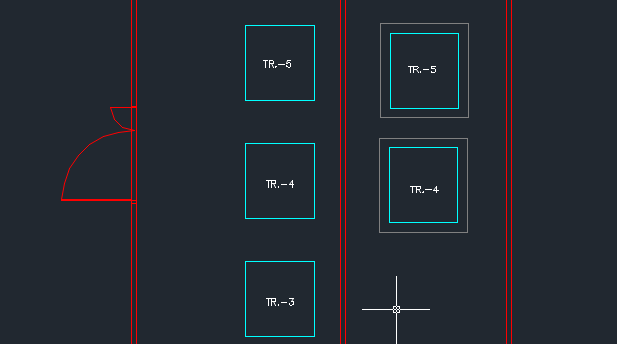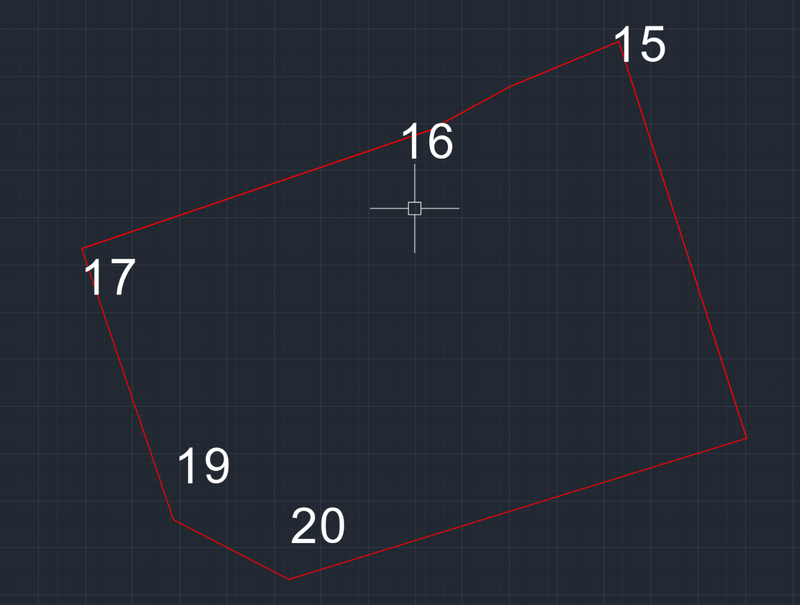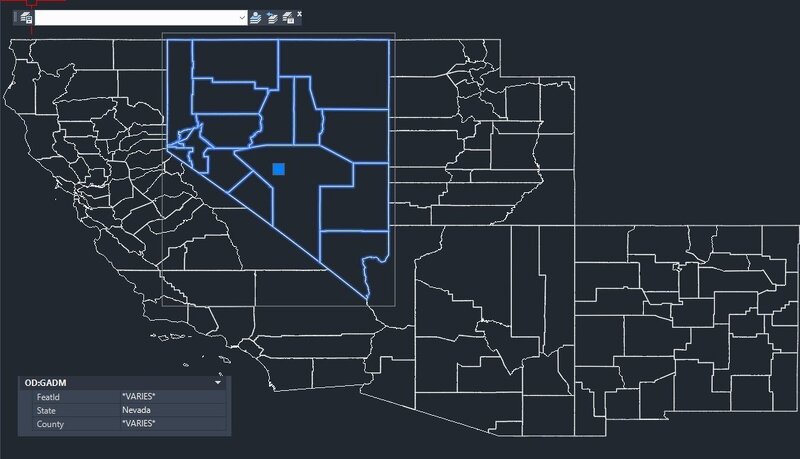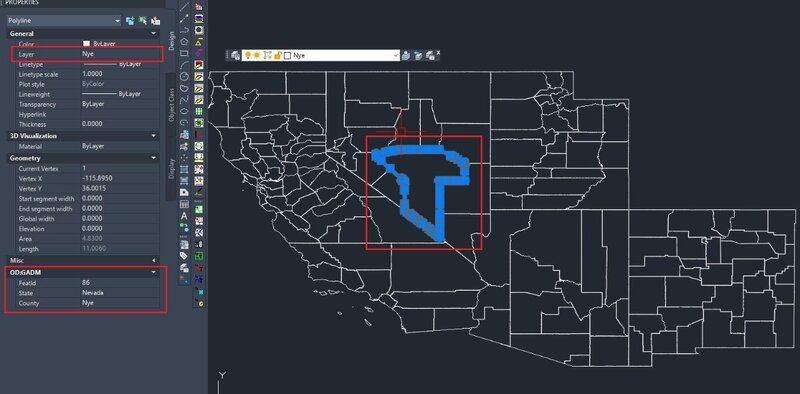Search the Community
Showing results for tags 'autolisp'.
-
Here is what I am trying to do. Draw a TRIM - FENCE from these two points to cut the vertical lines Here is my code (setq pt1 "0.5,1.0,0.0") (setq pt2 "3.0,1.0,0.0") (command "trim" "fence" pt1 pt2) If I execute this code, I get this (the lines are not trimmed) If I manually type TRIM - FENCE - !PT1 - !PT2 I get this (it works, I have to press enter to finish) What am I missing in getting this code/command to work the way I want?
-
Copy blocks to curve according to another curve
HypnoS posted a topic in AutoLISP, Visual LISP & DCL
Hi all, I was wondering if someone could help me with a lisp modyfication. I need to modify CopyBlockStoCurve lisp so I don't need to select each block individually co copy it to the curve. I thought why not copy a function from numpol, which numbers blocks according to a polyline. So I need the new CopyBlockStoCurve to arrange blocks on a curve, but in accordance with how the blocks are positioned on another polyline basiclly. Can anyone help? numpol.lspCopyBlocksToCurve.lsp- 36 replies
-
- autolisp
- block position
-
(and 3 more)
Tagged with:
-
Hi Everyone, Good day to all, I'm trying to customize a LISP routine to create PDFs using my own .pc3 and ctb file — specifically, I'm using "Foxit PDF Editor Printer.pc3". I tried replacing the default printer and setting a custom paper size, but the code isn’t working as expected. (defun c:PDF ( / cm ) (setq cm (getvar 'CMDECHO)) (setvar 'CMDECHO 0) (command "_.-plot" "_y" (if (= 1 (getvar 'TILEMODE)) "Model" (getvar 'CTAB)) "AutoCAD PDF (High Quality Print).pc3" "ARCH D (24.00 x 36.00 Inches)" "_M" "_L" "_N" "_E" "_F" "_C" "_Y" "monochrome.ctb" "_Y" ) (if (= 1 (getvar 'TILEMODE)) (command "_A") (command "_N" "_Y") ) (command "_N" (strcat (getvar 'DWGPREFIX) (vl-filename-base (getvar 'DWGNAME))) "_Y" "_Y") (setvar 'CMDECHO cm) (princ) ) (vl-load-com) (princ) When I replace the default .pc3 file in the LISP code with my own (Foxit PDF Editor Printer.pc3), instead of plotting automatically, it starts asking for every input again — like paper size, plot area, etc Command: PDF Yes or No, please. Don't use Esc while using a Lisp commandWrite the plot to a file [Yes/No] <N>: y Command: MOPRINT Yes or No, please. Don't use Esc while using a Lisp commandWrite the plot to a file [Yes/No] <N>: Save changes to page setup [Yes/No]? <N> Proceed with plot [Yes/No] <Y>: Effective plotting area: 903.11 wide by 603.25 high Plotting viewport 1. Effective plotting area: 792.73 wide by 577.98 high Plotting viewport 2. Also, it would be awesome if we could add a feature where each layout gets plotted using a name format and save location pulled from an Excel file. That would seriously save a ton of time and effort. Thanks in advance, friends!
-
After being stuck on this subject for a while, I know the answer is "don't use variables for the actions of an if statement" but I am still bothered as to WHY it does not work. I assume it has to do with the way the if function evaluates, but I cannot figure it out myself. I apologize in advance for the long read. For example, I created a short routine to give a positive or negative response dependent on whether or not the user input equals 1: (defun c:if (/ inp) (setq inp (getint "\nValue: ")) (if (= 1 inp) (print "You Did It!!!!!!!!!") (print "You FAILED") ) (princ) ) This routine works- I provide the action for the T or nil outcome within the if statement. However, if I assign variables instead: (defun c:if (/ inp yes no) (setq inp (getint "\nValue: ") yes (print "You Did It!!!!!") no (print "You FAILED") ) (if (= 1 inp) yes no) (princ) ) The routine doesn't know what to do with itself regardless of user input. It returns the nil outcome twice regardless of whether or not the user input value equals 1. I do not understand why it skips to the nil outcome if the statement is true.
-
About 2 weeks into my use of AutoLISP. I understand that mapcar evaluates each item seperately, and lamda is used as an undefined function, but: In what situation would you need to use mapcar and lamda? Why would you need an output of a string of values other than presenting the output to the user?
-
Hello, I have a question for all those lisp masters out there. The company that I work for has had me learning and creating lisp for them for a couple months now and we are starting to get a library of lisp built up. Currently I have all of the lisp being loaded at startup through the appload command. I have decided to use Lee Mac's Autoloader when necessary, but I was wondering at how many lisp would it be wise to do that for instead of at startup? Right now the PCs in the office are not filling slow (They are what I would consider to be in the middle of the road in power.).
-
I'm trying to write an Autolisp code to underlay images. It's built around the "-attach" command. When attaching a PDF you're asked for a page number (even if there's only one). I want my code to skip this step if there's only one page, default to 1 if there's more than one page & then default to 2, 3 etc. for multiple pages until there are no more (when it will go back to the select file dialogue). Problem is I cannot find how to check how many pages there are on the PDF. If, within AutoCAD, you type ? for page number then *, it lists all the pages, so AutoCAD can definitely check this before inserting the PDF, but I can't find any way of accessing this info. Any ideas?
-
My boss may have just asked for the impossible, but he wants a lisp to be able to window select multiple text then window select lines near the text, and have the text align to the line or polyline that is closest to the text. I have something that allows me to pick a line then a text, but I have no idea how to do this. Any help is greatly appreciated, this is way above my ability. The attached pictures show before and after.
-
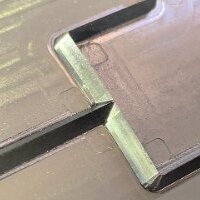
Draw a horizontal line with only midpoint and length available
Sharper posted a topic in AutoLISP, Visual LISP & DCL
Hi Guys I've searched for this assuming someone would hav already, and it seems like theres many similar but not the same. Between 20 and 100 times per day I need to draw a line, this line is always horizontal so no angle required. I would know its length (this is the 1st variable) and I have an endpoint to click on, which would be the midpoint of the line (2nd variable) Currently i'm drawing a line at its length and moving it from Midpoint to endpoint So i'm looking for a routine that asks for Pt1 (i can choose an endpoint of a line) Then asks for the line length (I input its total length) and it draws a horizontal line of that length, and the centre of this line is the endpoint i chose. Any and all help is appreciated, questions also welcome -
import csv file into autocad using autolisp and block reference (part2)
NanGlase posted a topic in AutoLISP, Visual LISP & DCL
Please, someone help me. I thought my program was in its final stages, but it is not. I used AutoCAD 2002 and 2007 during development, but when I tried to install it in AutoCAD 2021, this happened (see the picture). It prompts as if I need to edit the attributes one by one. Also, how can I eliminate the automatic prompts in the command line made by AutoCAD, while keeping the programmed prompts within the AutoLISP? (defun c:nancsv ( / fname dummy pts newline blockName height x y base-point auto-numbering num) (princ "\nImport CSV/Text File by: Nan Glase (2025-01-04)") ; (princ "\nEnter \"NANCSV\" to run.") ; (defun csv->lst ( str / pos ) (if (setq pos (vl-string-position 44 str)) ; (cons (substr str 1 pos) (csv->lst (substr str (+ pos 2)))) ; (list str) ) ) ; Set the block name (setq blockName "Nan Glase") ; Prompt for text height (setq height (getreal "\nEnter text height [0.60]: ")) ; Prompt for text height ; If the user presses Enter without input (height is nil), set the default value to 0.60 (if (not height) (setq height 0.60) ) ; Apply the formula (value entered / 2) (setq height (/ height 2)) ; Divide the height by 2 ; Define acceptable inputs for Yes and No (setq yes-options '("" "Y" "y" "Yes" "yes" "YES")) (setq no-options '("N" "n" "No" "no" "NO")) ; Prompt for automatic point numbering in a loop until valid input is given (setq auto-numbering nil) (while (not (or (member auto-numbering yes-options) (member auto-numbering no-options))) (setq auto-numbering (getstring "\nAutomatic point numbering? (Yes/No): ")) ) ; Start numbering from 1 if automatic numbering is enabled (if (member auto-numbering yes-options) (setq num 1) (setq num nil) ; Set num to nil if automatic numbering is not enabled ) ; Open the CSV file (setq fname (open (getfiled "Import CSV/Text File" "d:\\" "csv;txt" 16) "R")) (setq dummy (read-line fname)) ; ; (while (setq newline (read-line fname)) (setq pts (csv->lst newline)) ; ; If automatic numbering is enabled, modify the first element in pts (if num (setq pts (cons (itoa num) (cdr pts))) ; ) ; Extract coordinates from the list (setq x (atof (nth 2 pts))) ; X coordinate from CSV (setq y (atof (nth 1 pts))) ; Y coordinate from CSV (setq base-point (list x y)) ; Create the base point list ; Insert the block reference with the specified base point (command "-insert" blockName ; base-point ; Use the base point defined above height ; Scale X (use the calculated height) height ; Scale Y (use the calculated height) 0 ; Rotation (nth 0 pts) ; column A from CSV (last pts) ; column E from CSV (nth 3 pts) ; column D from CSV ) ; Increment the number for the next point if automatic numbering is enabled (if num (setq num (1+ num)) ) ) ; Close the file after processing (close fname) ; Close the file ; Notify user that the process is complete (princ "\nProcess completed successfully!") ; Completion message (princ) ; End of the function ) ; (princ "\nImport CSV/Text File by: Nan Glase (2025-01-04)") (princ "\nEnter \"NANCSV\" to run Import CSV/Text File.") Nan Glase.dwg -
Need help. how to maintain 3 decimal places even with zeros like in the picture? (defun c:nanpt () (vl-load-com) (princ "\nStakeout Point by: Nan Glase (2024-12-24)") (princ "\nEnter \"NANPT\" to run.") (setq points '()) (setq polyline nil) ; Variable to hold the polyline object ;; Start the polyline command (command "_.PLINE") (while t (setq pt (getpoint "\nSelect a point (or press Enter to finish): ")) (if (null pt) (progn ;; Finish the polyline if at least one point was selected (if (> (length points) 0) (progn (command "") ; End the polyline command (setq polyline (entlast)) ; Get the last entity created (the polyline) ;; Save points to a file (setq data '()) (setq i 1) (foreach p points (setq line (strcat "S" (itoa i) ", " (rtos (cadr p) 2 3) ", " (rtos (car p) 2 3) ", 0")) (setq data (append data (list line))) (setq i (1+ i)) ) (setq formattedData (apply 'strcat (mapcar (function (lambda (x) (strcat x "\n"))) data))) (setq tmpfile (vl-file-syst-write (strcat (getenv "TEMP") "\\Nan_stakeoutpoint.txt") formattedData)) (startapp "notepad.exe" tmpfile) ) (princ "\nPlease select at least one point before finishing.") ) (if polyline (progn (command "_.ERASE" polyline "") ; Erase the polyline (setq polyline nil) ; Clear polyline reference ) ) (setq points nil) ; Clear points list ) (progn ;; Append the point to the list (setq points (append points (list pt))) ; Store the point directly (command pt) ; Add the point to the polyline ) ) ) (princ) ) (defun vl-file-syst-write (filename content) (setq file (open filename "w")) (if file (progn (write-line content file) (close file) (princ (strcat "\nData has been written to Notepad. " filename)) ) (princ "\nError opening file for writing.") ) filename ) (princ "\nStakeout Point by: Nan Glase (2024-12-31)") (princ "\nEnter \"NANPT\" to run.")
-
import csv file into autocad using autolisp and block reference
NanGlase posted a topic in AutoLISP, Visual LISP & DCL
please help me write a code. i have csv file contains point, northing, easting, elevation, description. i also have a drawing file that has attributes-point,description,elevation. this drawing file is in a support file search path. i want to make an autolisp that import csv data into autocad. The northing and easthing will be the location of the point. NANCSV.DWG SURVEY POINTS.csv -
I got this code from chatgpt, that chatgpt got from a defunct post from autocad website forums. Whenever I tried going to the website or googling, the link seems broken so I don't know how this code exactly works. I am trying to make a Lisp that creates dimstyles from scratch. everything is working except for changing between annotative and non annotative. The code below does a good job of setting the created dimension style to annotative. But when I ask chat gpt to make it in reverse, i.e. make a code that makes the created dimstyle non annotative, it can't. (defun set-dimstyle-annotative (dimstyle-name / ent entdata xdata) ;; Ensure the dimension style exists (if (and (setq ent (tblobjname "dimstyle" dimstyle-name)) (setq entdata (entget ent))) (progn ;; Check if XData for "AcadAnnotative" exists (if (not (assoc -3 entdata)) (progn ;; Add XData to set the dimension style as annotative (setq xdata '((-3 ("AcadAnnotative" (1000 . "AnnotativeData") (1002 . "{") (1070 . 1) ; Version number (1070 . 1) ; Annotative flag: 1 = Yes, 0 = No (1002 . "}") ) ) ) ) ;; Apply the XData to the dimension style (entmod (append entdata xdata)) (princ (strcat "\nDimension style '" dimstyle-name "' set to annotative.")) ) (princ (strcat "\nDimension style '" dimstyle-name "' is already annotative.")) ) ) (princ (strcat "\nDimension style '" dimstyle-name "' not found.")) ) (princ) ) Basically when a dimstyle is created, I put this at the end of the code to make it annotative. However, after making an annotative dimstyle, I can make a dimstyle, but because the previous was annotative, I cannot set the new dimstyle to non annotative. Chat gpt gave me a code but it seems it just butchered the code and it doesn't work. I attached the lisp file. Thanks!! DimStyles.lsp
- 2 replies
-
- annotative dimension
- autolisp
-
(and 1 more)
Tagged with:
-
find the dimension and polyline distance using AUTOLISP
keku posted a topic in AutoLISP, Visual LISP & DCL
I'm new to Lisp and trying calculate the distance from a wall to a polygon box, as well as the distance between two polygon boxes. Additionally, I need to determine the dimensions of both the polygon box and the wall. I'm using Lee Mac's dimensioning code as a reference and trying to modify it to achieve these calculations.can i get this type of outcome using lisp -
It's a bit complicated for me to explain this. In this case, numbers should be selected and moved to the nearest point or vertex, and when moved, the text should not intersect any lines or polygons. Moving isn't that much of a problem, but the latter is. My idea is to create a rectangle around the text using the TCIRCLE function and then move the rectangle along the edge of the circle (where the center of the circle is the moving point) of some radius until it is not intersected by lines, if there is no such place then the radius increases by some value, it doesn't matter which one. Anyway, maybe I'm asking to much let me know guys if you have a suggestion. THANKS
-
Hello, This question is in reference to AutoLisp, but the specific CAD version this is used for is MicroSurvey CAD 2020. We are running into an issue where the PRINT dialog coordinates are completely different than the real coordinates reported by AutoLISP and the objects properties in CAD. As an example, on one drawing, the coordinate of the bottom left of a box is (606625.433, 4841479.138), however this coordinate is reported by the print dialog to be (4207152.580, 2471093.689). This means when the automatic print functions calculate the box coordinates, they rightly get the bottom left of the box to be at (606625.433, 4841479.138), but this is not correct for the print dialog resulting in the print not even capturing any part of the drawing. The drawing is a 2d flat image on the top face, and the main bounding box of the drawing is not aligned with the x/y axis. I initially assumed this was an issue between model and paper space, but the coordinates seem large enough that the paper-space ones do not make sense. If anyone has experience with this sort of coordinate issue please let me know. I can share more information if needed.
-
Link selected object data to block attribute by selecting objects
srikanth_0126 posted a topic in AutoLISP, Visual LISP & DCL
Hi, This is my first after so many days using this site. my block have multiple attributes for different types of lengths and one(DUCT_ID) attribute for sequence. i want to link objects length to block attribute(its a field)(MICRODUCT) by using TAG(DUCT_ID). HOW IT WORKS. command to select the objects then ask for DUCT_ID. then link the selected objects to MICRODUCT. i'm using lee mac length2 field for now. but in this lisp you have to select the block manually. but blocks our drawing usually in different location initially for easy to work. thanks in advance. -
Please Help Me! Insert Multiple Block Attributes at Geometric Center
Kvlar posted a topic in AutoLISP, Visual LISP & DCL
I found autolisp code on this forum with the function of inserting multiple blocks at the center point circle. Can anyone help me to make a code like this but with function to inserting multiple blocks (Attribute Blocks) at the geometric center of a closed polyline Thank you This is the code for inserting multiple blocks at the center point circle : BlockOnCircle.lsp -
Remove a section of text in a text file from between 2 keywords with autolisp or visual lisp
Mr Bojangles posted a topic in AutoLISP, Visual LISP & DCL
Hi guys I'm not sure that this is possible but hey you guys know a hell of a lot and surprise me often. Is it possible in lisp to look inside a text file and remove some text from between 2 keywords? For example The text filename would be the same as the cad file, but it's on another network location. I can create a variable that concatenates the file name and location. This I know I can do lol. Then I want the lisp to open the file find Keyword1 and keyword2 (always the same and only ever 1 of each in the file, also there would always be text before and after the keywords which should be kept intact). Then remove any text that lies between them. And finally resave the file. I've done some searches but I keep getting results for editing text inside of cad, which isn't what I'm after, or recommending using other programming language, but I've no idea how to do that. Which is why I'm pinning my hopes on this.- 29 replies
-
Hello everyone, can anyone help me, I have a case example that is almost similar to the actual case I am experiencing now. In the 1st picture I have a shapefile of the administrative boundaries of the United States that I have entered into autocad, the shp attribute has been entered into the data object of each feature with the data object name "GADM", in the data object there are State and County fields, for the layer of each feature I use the County field reference so that each feature is currently layered with its respective county name. what I want is that as in the 2nd picture I want each feature to be grouped or made per block per category of state, is there a quick way, because I think in each feature there is a State field? Noted: The Autocad that I use is AutocadMap 2021. Pic 1 Pic 2
-
I have one AutoLISP to insert Dynamic Blocks containing Attributes. With this AutoLISP I can select the Value Attribute via the List DCL. I can insert Dynamic blocks wherever I want. The problem is, I want to use this AutoLISP by inserting dynamic blocks simultaneously at the midpoint of the line. what should I do? can anyone help me Thank You
-
autolisp writes the intersecting line layer name to the center of the block
bery35 posted a topic in AutoLISP, Visual LISP & DCL
Hi, I tried to write an autolisp code and I got to a certain point, but it is not working as I wanted. I would like your suggestions and your support in revising the code. What I want to do is select a block. To find out which character (n) from the right is the "-" sign in the layer name of the line touching the block I selected. Then subtract 1 from this character(n) number and add n-1 from the right. Combining the part up to the character and the prefix text and writing to the block geometric point. The way this code works now is to combine the front text and the text to the right of the "-" sign of the last layer added to the layer list and write it to the center of the block. This wasn't something I wanted. (setq *textHeight* 8) (setq *layerName* "01 Equipment list 2") (setq *textColor* 1) ; (defun c:bs_ayar () (setq *textHeight* (getreal "\nEnter new text height: ")) (setq *layerName* (getstring "\nEnter new layer name: ")) (setq *textColor* (getint "\nEnter new color index (1 for Magenta): ")) (princ (strcat "\nText height is now " (rtos *textHeight*) ", layer name is " *layerName* ", color is " (itoa *textColor*) " was set to. ")) (princ) ) (defun c:bs4 () (setq prefix (getstring T "\nEnter prefix letter: ")) (setq blk (car (entsel "\nSelect Block: "))) (setq blkEnt (entget blk)) (setq insPt (cdr (assoc 10 blkEnt))) (setq ss (ssget "_X" (list (cons 0 "LINE,POLYLINE")))) (if (and ss (> (sslength ss) 0)) (progn (setq line (ssname ss 0)) (setq lineEnt (entget line)) (setq lineLayer (cdr (assoc 8 lineEnt))) (setq dashPos (vl-string-search "-" lineLayer)) (if dashPos (setq rightPart (substr lineLayer (+ dashPos 2))) (setq rightPart lineLayer) ) (command "._-LAYER" "_M" *layerName* "" "_C" *textColor* "" "") (command "._TEXT" insPt *textHeight* "" (strcat prefix rightPart)) (command "._-LAYER" "_S" *layerName* "") ) (princ "\nNo line or polyline was found touching the selected block.") ) (princ) )-
- intersecting
- line
-
(and 2 more)
Tagged with:
-
Selecting text from a pop-up window and pasting it on the screen
bery35 posted a topic in AutoLISP, Visual LISP & DCL
Hello, I have a lisp code that I have been working on and I have brought it to a certain stage. However, I am having a problem at one point. In this lisp code, I have a product list with my purpose defined. When the code runs, my product list is listed in the pop-up window. And I choose what I want and paste it to the places I specify on the screen. However, my product list can be up to 500 items, so I created a search button in the popup window. The button works, but it is based on the line number I choose, not the product name I choose, and it writes the product on this line number in the general list to the screen. I need support on how to overcome this problem. main command (defun C:prdef (/ dcl_id product_list product filter_list pt index) (create-layer "00-Equipment List" 3) ; Number 3 is used for green color (setq product_list '("Product-1" "Product-2" "Product-3" "Product-4" "Product-5" "Product-6" "Product-7" "Product-8" "Product-9" "Product-10" "Product-11" "Product-12" "Product-13" "Product-14")) (setq dcl_id (load_dialog "product_select.dcl")) (if (not (new_dialog "product_select" dcl_id)) (exit) ) (start_list "product_list") (mapcar 'add_list product_list) (end_list) (action_tile "search_box" "(progn (setq filter_text $value) (update_list filter_text))") (action_tile "product_list" "(setq product (nth (atoi $value) product_list))") ; (action_tile "ok" "(done_dialog)") (action_tile "search_button" "(update_list filter_text)") ; (start_dialog) (unload_dialog dcl_id) (initget 1) (while (setq pt (getpoint "\nChoose a location (exit with ESC): ")) (setq index (atoi product)) ; (command "_.-layer" "_S" "00-Equipment List" "") ; (command "_.text" pt default-text-height 0 product) ; (command "_.-layer" "_S" "0" "") ; ) ) ; List update function (defun update_list (filter_text / filtered_list) (setq filtered_list (if (= filter_text "") product_list (vl-remove-if-not '(lambda (x) (vl-string-search (strcase filter_text) (strcase x))) product_list ) ) ) (start_list "product_list") (mapcar 'add_list filtered_list) (end_list) (set_tile "product_list" "") ) In my dcl code as follows product_select : dialog { label = "Product Select"; : edit_box { key = "search_box"; label = "search"; width = 40; } : button { key = "search_button"; label = "search"; is_default = true; } : list_box { key = "product_list"; multiple_select = false; fixed_width = true; width = 40; } ok_cancel; }- 6 replies
-
- autolisp
- pop window
-
(and 1 more)
Tagged with:
-
Is there any chance of matchline automation using lisp in layout? I have attached sample dwg and screenshot of block for matchline. Please help. And thanks in advance. SRS.dwg
-
Dears, AUTOLIPS works on the english version but i want to use it on the frensh version, any kind of support Thanks





